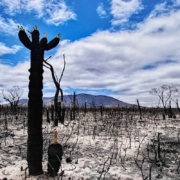Keeping hope alive, or ourselves?

We must hope. Hope is good. Politicians, businesspeople, and even climate activists keep hammering it home, but research shows that people who worry are more likely to take action together.
Hope is mandatory. Change is impossible without positive thinking and belief in a better future. The upcoming UN Biodiversity Summit COP16 in Cali, Colombia, and the Climate Summit COP29 in Baku, Azerbaijan, will echo the hope mantra. As before, these events may produce limited immediate action but will likely generate ambitious long-term plans, including roadmaps, commitments, and targets to inspire optimism for a far future. This talk of hope and future-oriented promises will likely reach its peak during the US presidential elections, where candidates compete to promise America’s eternal dream of forever economic growth.
However, this focus on distant goals and optimistic rhetoric may not address pressing current issues. The emphasis on future plans and the “American Dream” narrative can overshadow the need for concrete, immediate actions to address environmental and social challenges.
Hope as a problem
But what if hope is actually the problem? What if hope is the antidepressant that keeps us all nicely numb, while we have every right to be sad, worried, spurred to action, or just angry, Jonathan Watts asks in The Guardian.
New research shows that people who experience stress due to climate change are more likely to take action together. And history shows that artificial optimism can lead to indifference and avoiding responsibilities.
Yes, there’s good news too, even in environmental matters: the enormous growth of renewable energy has surpassed even the most optimistic predictions. But much of the additional supply has been absorbed by the extra demand from artificial intelligence, cryptocurrencies, and social media. CO2 emissions could really decrease this year. But analysts have been saying that for years, and if it does happen, the decrease will certainly be too small to prevent global warming from exceeding 1.5°C, probably 2°C, and possibly even 3°C or 4°C. And the world population could peak by mid-century. That could give other species more breathing room if they haven’t gone extinct by then, according to Watts.
Then what?
I’ve long advocated for a radically realistic attitude. Acknowledge where we stand and what the consequences are. Acknowledge how promises for better from the past have only been broken. It prevents the repeated disappointment of hope that repeatedly goes up in smoke. That has a paralyzing effect.
Renee Lertzman is a psychologist who thinks in the same direction. She links that realism to acknowledging people’s fear. Take people along in the knowledge that you’re scared too, that it’s okay to be scared, and name the problems. Acknowledge that it’s complex and difficult. When people connect in that knowledge, they can feel safer together and work on solutions.
Hope is at best a motivating belief, a tool, a product, says Watts. It should never be forced down other people’s throats, especially not those experiencing the consequences of the wishful thinking of richer, distant consumers.
“The politics of hope is about seducing us to focus on the promise of the future instead of the challenges in the present,” write Marjo Lindroth and Heidi Sinevaara-Niskanen from the University of Lapland.
The church sells hope for forgiveness. Politics sells hope for freedom. The economy sells hope for wealth. Hope sells and it keeps the kind of economy alive that’s ruining us. That’s exactly what I’m afraid of.
Peet Osta




